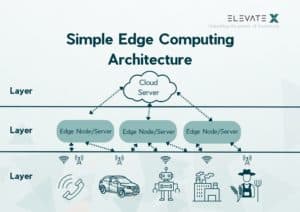Edge computing is increasingly becoming a key technology for companies that require real-time data processing. From accelerating data transfers to reducing latency, edge computing offers numerous benefits. In this article, you’ll learn how edge computing is revolutionizing real-time data processing and why it’s essential for modern businesses.
Introduction
What is edge computing?
In short, it is the relocation of data processing closer to where the data is generated. Instead of sending all the data to remote data centers, the analysis takes place nearby or even on the end device itself. This saves time and bandwidth.
Development and importance of edge computing
The development of edge computing began in response to the ever-increasing volume of data and the need for real-time processing. With more and more networked devices in the Internet of Things (IoT), it became clear that central cloud solutions were often too slow and inefficient. Edge computing solves this problem by:
- Local data processing
- Lower latency
- More efficient use of bandwidth
Why are more and more companies turning to this technology?
Why are so many companies jumping on this bandwagon? It’s simple: speed and efficiency. In industries where milliseconds make the difference, edge computing provides a decisive advantage. Just imagine:
- An autonomous vehicle would first have to send its data to a remote data center for processing. This delay could have fatal consequences.
- With edge computing, such data is processed directly on site, which drastically shortens response times and reduces the network load at the same time.
It is clear that edge computing has become a key technology for a reason. More and more companies are therefore turning to this solution in order to remain competitive and optimize their processes.
- Edge computing reduces latency and improves efficiency through local data processing.
- Industries such as manufacturing, healthcare and transportation benefit in particular from the fast response times and higher data security.
- The implementation of edge computing requires technological adaptations and continuous training of the teams.
- Future prospects show that edge computing will play a decisive role in the further development of the IoT and enable new innovations.
The importance of real-time data processing
Real-time data processing is crucial for many companies. It enables faster decision-making and optimized processes. In modern business environments, every second counts. The ability to analyze and respond to data instantly can provide a significant competitive advantage.
Acceleration through edge computing
Edge computing accelerates this process enormously. Moving data processing closer to the data source drastically reduces the time data spends traveling. Companies can access and respond to critical information faster without having to wait for a remote data center to respond. This is particularly important in industries such as healthcare. Here, access to real-time data can make or break a patient’s life.
Advantages of lower latency
Another advantage of edge computing is lower latency. Traditional cloud solutions often require the transmission of large amounts of data over long distances, which leads to delays. With edge computing, this data is processed locally, minimizing latency and enabling almost instantaneous data processing. This not only improves efficiency, but also the user experience, as applications and services work faster and more reliably.
Positive impact on network utilization
The lower latency also has a positive impact on network utilization. Less data traffic between end devices and central servers reduces the load on networks and lowers the cost of bandwidth usage. For companies, this means considerable savings and improved system performance at the same time.
Flexibility and agility through real-time data processing
Focused real-time data processing with edge computing allows companies to react more flexibly and agilely to market changes and customer requirements. This leads to optimized operating processes, faster response times and ultimately to greater customer satisfaction. The integration of edge computing into a company’s IT infrastructure is therefore often a decisive step towards a future-proof and competitive organization.

Edge computing in various industries
Edge computing is particularly beneficial in numerous industries. In the manufacturing industry, for example, it enables better equipment monitoring and maintenance. Real-time data from machines is processed directly on site so that problems can be identified and rectified immediately. This not only saves time, but also prevents costly downtime. Companies such as Siemens are already using this technology to make their production processes more efficient.
Edge computing plays a critical role in the healthcare sector. Clinics and hospitals benefit from faster processing of patient-related data. Diagnoses and treatments can be accelerated, which can be life-saving in emergency situations. Edge computing allows medical devices to analyze data locally and draw immediate conclusions. Patient privacy is guaranteed, as sensitive data does not have to be transferred to remote cloud servers.
Edge computing is also making considerable progress in the transportation sector. Autonomous vehicles rely on the immediate processing of sensor data to navigate safely and efficiently. Local data analysis enables these vehicles to react more quickly to traffic conditions and avoid accidents. Companies like Tesla and Waymo are turning to edge computing to improve the performance and safety of their autonomous systems.
In all of these areas, edge computing solves specific challenges through faster data processing, increased operational efficiency and improved safety. It is clear that edge computing has established itself as a key technology that helps various industries to manage their unique requirements and optimize their processes.
Benefits of edge computing for businesses
Edge computing has a number of advantages for companies. One major advantage is the decentralization of data processing. Instead of sending all data to a central server, it can be processed directly at the point of origin. This shift leads to a significant reduction in latency, as the data does not have to travel through different networks. For companies, this means faster response times and more efficient data processing.
Another advantage is the reduction in bandwidth usage. With conventional cloud solutions, a large amount of data has to be transferred via the internet, which puts a considerable strain on bandwidth usage. Edge computing minimizes the need for this extensive data transfer, as the majority of data processing takes place locally. This enables companies to save considerable costs and reduce the load on their networks.
Security and data protection are also improved by edge computing. As data is processed locally, it does not need to be constantly transmitted over public networks, minimizing the risk of data leaks and cyberattacks. This is particularly important for industries that work with sensitive data, such as healthcare or the financial sector.
In summary, edge computing offers companies improved efficiency, lower operating costs and greater security. It enables faster and more reliable processing of data, which can make a crucial difference in today’s fast-paced business world. Edge computing is therefore a key technology that helps companies stay competitive and optimize their processes.
Challenges and solutions when implementing edge computing
The implementation of edge computing is not without its challenges. From a technological perspective, it requires a significant transformation of existing IT infrastructures. Companies need to ensure that their hardware is robust enough to support local data processing. Network security needs to be reassessed as more devices and endpoints now need to be monitored locally. This distributed structure increases the potential attack surfaces, making strict security management essential.
Organizationally, companies are faced with the task of training their IT teams accordingly. Edge computing brings with it new technologies and concepts that need to be understood and used efficiently by employees. This includes knowledge of real-time data processing, network administration and IT security, especially in the context of edge environments. The changeover requires close cooperation between IT and specialist departments in order to integrate the new systems and adapt them to the specific needs of the company.
But how can these challenges be overcome? Successful implementation begins with the selection of the right partners and services. Companies should rely on proven solutions and seek advice from experts to develop customized implementation plans. Various pilot projects can help to test the technologies on a small scale and identify potential problems at an early stage. This iterative approach ensures that the final implementation runs more smoothly.
It is advisable to start with non-business-critical applications first. In this way, companies can gain initial experience and gradually expand their systems. Clear documentation and regular training are essential to embed knowledge in the company and ensure that all relevant employees are up to date. With targeted planning and continuous training, edge computing can be seamlessly integrated into the existing infrastructure and the numerous benefits of this technology can be fully exploited.
With these measures in place, companies are well equipped to overcome the hurdles of implementation and reap the enormous benefits of edge computing.
Future prospects: Edge computing and IoT
Edge computing plays a central role in the further development of the Internet of Things (IoT). Decentralized data processing enables IoT devices to work faster and more efficiently. This not only enables better performance, but also new areas of application and business models. From smart cities, where traffic systems are monitored and controlled in real time, to smart factories, where machines can diagnose and repair themselves, numerous innovative applications are opening up.
The importance of edge computing will continue to grow in the coming years. Forecasts show that the number of networked devices will grow exponentially. This requires powerful and scalable infrastructures that can only be provided by edge computing. Companies and cities that adopt these technologies at an early stage will have a clear advantage.
The trends in edge computing indicate that technologies such as artificial intelligence and machine learning will be increasingly integrated into edge environments. This means that complex analyses and decisions can be made directly on site without having to rely on central cloud servers. This leads to even faster response times and opens up new possibilities for personalized and local services.
Possible innovations also include the integration of blockchain technologies to ensure the security and integrity of decentrally processed data. This is particularly important in sensitive areas such as healthcare or the financial sector. In addition, new types of hardware solutions that are specially optimized for edge computing could further increase efficiency and performance.
Overall, edge computing in combination with the IoT will fundamentally change the way we live and work. Companies that recognize and implement these developments at an early stage can benefit from a significant competitive advantage and strengthen their innovative power in the long term.
Conclusion
Edge computing has the potential to fundamentally change the way companies process and use data. The key technology enables fast and efficient data processing directly on site, resulting in less latency and greater data security. By reducing dependence on central cloud servers, companies can not only save costs but also improve their responsiveness and flexibility.
The integration of edge computing in various industries is already showing impressive results. Whether in manufacturing, healthcare or transportation, the benefits are diverse and profound. The ability to process data in near real time opens up new opportunities for innovation and efficiency gains that can overcome even complex challenges.
Companies that adapt this technology early on can benefit from a significant competitive advantage. The key lies in having the right implementation strategy, continuously training teams and choosing the right technologies and partners. Edge computing is more than just a trend – it is a forward-looking development that can help companies optimize their processes and achieve their goals.
The opportunities opened up by edge computing are numerous. It is up to companies to recognize and exploit these opportunities. With the right approach and a clear focus on the benefits of this technology, companies can consolidate their position in an increasingly fast-paced and interconnected market. The time is ripe to take a closer look at edge computing and fully exploit its potential.









